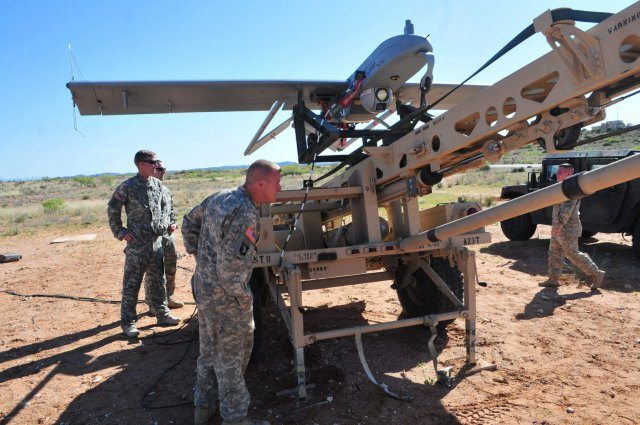Tiny Army satellites may someday provide Soldiers with voice, data and even visual communications in remote areas, which lack such communications. Already some of that technology has been successfully tested, Dr. Travis Taylor said.
Taylor is the senior scientist for Space Division, U.S. Army Space and Missile Defense Command – Tech Center, or SMDC, at Redstone Arsenal, Alabama. He spoke during Lab Day at the Pentagon, May 14.
VOICE AND DATA
In many remote areas, where Soldiers operate today, Army radio over-the-horizon communication from the field to higher headquarters like the brigade is nonexistent, Taylor said.
To address this gap in coverage, Army scientists and researchers built the SMDC-ONE nanosatellite, he said, the ONE standing for Orbital Nanosatellite Effect. “It’s basically a cellphone tower in space, except it’s not for cellphones, it’s for Army radios,” Taylor said.
SMDC-ONE is a technology demonstration, he said, adding that one has been successfully tested. It is up in space right now communicating. Three more are scheduled to go up this year and an undetermined number will go up next year as well.
“Hopefully, we’re at a point in the process where the technology is proven and they’re wanted, perhaps three to five years” from now, Taylor said.
“If we put five to 12 of these small satellites in orbit, it will cover most areas Soldiers are operating, providing them real-time, all the time” communications, he said. Once it has been proven it can be done, it will be time to start to deploy a “real constellation” of them, which the warfighters can use.
IMAGERY
What if a Soldier not only wants to communicate, but wants to see if there is a threat or something of interest over the next hill or the other side of a city, Taylor asked rhetorically.
The answer is an imaging satellite, which is several times larger than SMDC-ONE, but still considered nano, he said. This satellite, which is still unnamed, will be given a space test-flight in February, launched from the International Space Station.
The imaging satellite will produce a ground resolution of two to three meters, he said. That is high enough resolution to inform a Soldier if he is looking at a tank or a truck. Or, if there is smoke in an urban area, the Soldier will be able to tell which building it’s coming from. “This is capability the Army doesn’t have right now.”
Once the technology is successfully demonstrated, the next step will be to establish the process for how it works and provide training to the Soldiers.
“The first step is proving we can collect [the data] and the next step is disseminating it,” he said. For example, a squad leader might need to ask [a] brigade for an image over the next hill. Someone at brigade would need to prioritize that request, because the satellite can only process one image at a time, usually in about a minute.
Then, the data from that image or even the image itself would need to be pushed out to the Soldier on the ground, he said. The details are still fuzzy about how all of that would work, so the focus for now is getting through the demonstration phase.
HOW IT’S PUT IN SPACE
The technology is already proven, Taylor said. The biggest challenge is getting the satellites hitched on a ride into space, where they would be in low-Earth orbit. Most are launched now by piggybacking them as part of a larger payload of a spaceship.
One problem is, you cannot put rocket motors on these to change their orbits, because it is considered too dangerous for the mothership and the other payloads, he said, meaning it could inadvertently explode. So, when the mothership drops off its payloads, the Army satellite might not be in an optimal position in space since the mothership cannot zigzag around dropping off each payload in different places where their optimal orbits are located.
“So we developed a clever way around that,” Taylor said, holding up a plastic container about the size and shape of a fancy pill bottle.
“This is an actual rocket motor, made from a plastic printer,” he said. “Inside is liquid nitric oxide and a sparker – just like a barbeque lighter inside – so the nitric oxide combusts with the plastic” when the sparker is fired. “That’s your rocket fuel. Then you have a very good rocket motor.”
Once the rocket motor puts the satellite in correct orbit, the satellite still needs to orient its solar panel array so it is continuously tracking the sun and collecting energy, he said.
To do that, the satellite contains three wheels spinning in the x, y and z axis called momentum wheels, he said. They act like gyros and can be programmed by speeding or slowing each one to adjust the orbit or orientation of the spacecraft. There are also magnetic torque rods in the satellite that interact with the magnetic field of the Earth to help align it.
Once in space, the satellites are not completely immune from damage, Taylor said. Besides space debris, there is solar flares and coronal mass ejections that could penetrate the satellite’s shielding. “But we do everything we can to harden and ruggedize them.”
These satellites are very inexpensive, he said, adding the biggest cost is the launch.
“It’s exciting to work with spacecraft that can actually help warfighters in the field of the future,” Taylor said. “We’ve had many would-be users tell us that if they had this, they’d use it tomorrow, so I think the odds are good this will be something we see in the future.”











